|
|
|
|
Damped multichannel singular spectrum analysis for 3D random noise attenuation |
Next: Conclusion Up: Huang et al.: Damped Previous: Damped MSSA
To demonstrate how the proposed algorithm works in practice, we apply the damped MSSA algorithm on two 3D post-stack field datasets. The first field data is shown in Figure 6a. Figures 6b and 6c show the denoised data using the traditional and damped MSSAs, respectively. Figures 6d and 6e show the removed noise using the traditional and damped MSSAs, respectively. In this test, in order to preserve the main features of the original data, we use a more conservative combination of ![]() and
and ![]() (
(![]() and
and ![]() in this example). A denoising comparison of the 5th crossline section is shown in Figure 7. The top row of Figure 7 shows the comparison between the raw data and the denoised data using the traditional MSSA and the damped MSSA. The bottom row of Figure 7 shows a comparison of the removed noise sections using two methods. It can be observed that the denoised section using the damped MSSA (Figure 7c) is cleaner than that of the traditional MSSA (Figure 7b). The noise section of the damped MSSA is obviously noisier than that of the traditional MSSA, which indicates that the damped MSSA can attenuate more random noise. Since there is almost no coherent energy in the noise sections, both denoising results would be acceptable, but the proposed approach obtains a better performance. Figure 8 shows three zoomed parts from the crossline sections of the raw data and two denoised data, as highlighted by the frameboxes in Figure 7, which gives us a more detailed comparison. The MSSA approach obtains a big improvement of the image considering the signal-to-noise ratio (S/N) while the DMSSA approach obtains a even better performance. The events using the DMSSA approach become more continuous than the MSSA approach, without remaining any random noise, and both approaches well preserve the discontinuities in the image.
in this example). A denoising comparison of the 5th crossline section is shown in Figure 7. The top row of Figure 7 shows the comparison between the raw data and the denoised data using the traditional MSSA and the damped MSSA. The bottom row of Figure 7 shows a comparison of the removed noise sections using two methods. It can be observed that the denoised section using the damped MSSA (Figure 7c) is cleaner than that of the traditional MSSA (Figure 7b). The noise section of the damped MSSA is obviously noisier than that of the traditional MSSA, which indicates that the damped MSSA can attenuate more random noise. Since there is almost no coherent energy in the noise sections, both denoising results would be acceptable, but the proposed approach obtains a better performance. Figure 8 shows three zoomed parts from the crossline sections of the raw data and two denoised data, as highlighted by the frameboxes in Figure 7, which gives us a more detailed comparison. The MSSA approach obtains a big improvement of the image considering the signal-to-noise ratio (S/N) while the DMSSA approach obtains a even better performance. The events using the DMSSA approach become more continuous than the MSSA approach, without remaining any random noise, and both approaches well preserve the discontinuities in the image.
The second field data example is shown in Figure 9a. The reflectors in this example are more complex with steeper dips compared with the first field data example. The two denoised results are shown in Figures 9b and 9c. Figures 9d and 9e show the removed noise cubes using the traditional MSSA and the damped MSSA, respectively. It is clear that the proposed approach can remove stronger noise compared with the traditional MSSA approach, as can be see from Figure 9. In this example, because of the steeper dip of reflectors, we use higher ![]() compared with the previous field data example. In practice, when the seismic data becomes more complicated, a higher
compared with the previous field data example. In practice, when the seismic data becomes more complicated, a higher ![]() value should be used to account for the higher rank caused by the larger number of dip components. For this example,
value should be used to account for the higher rank caused by the larger number of dip components. For this example, ![]() and
and ![]() . The 10th crossline sections from the raw data, the denoised data using the traditional MSSA approach, and the denoised data using the damped MSSA approach, are shown in Figures 10a, 10b, and 10c, respectively. The bottom row of Figure 10 shows the zoomed sections that correspond to the frameboxes in the top row. It is clear that the proposed approach can obtain smoother and cleaner reflections than the traditional MSSA approach. For all the three examples, we do not use local processing windows to apply the MSSA or DMSSA algorithm, because the data size is not big and data structure is not very complicated, which makes the performance using MSSA still acceptable.
. The 10th crossline sections from the raw data, the denoised data using the traditional MSSA approach, and the denoised data using the damped MSSA approach, are shown in Figures 10a, 10b, and 10c, respectively. The bottom row of Figure 10 shows the zoomed sections that correspond to the frameboxes in the top row. It is clear that the proposed approach can obtain smoother and cleaner reflections than the traditional MSSA approach. For all the three examples, we do not use local processing windows to apply the MSSA or DMSSA algorithm, because the data size is not big and data structure is not very complicated, which makes the performance using MSSA still acceptable.

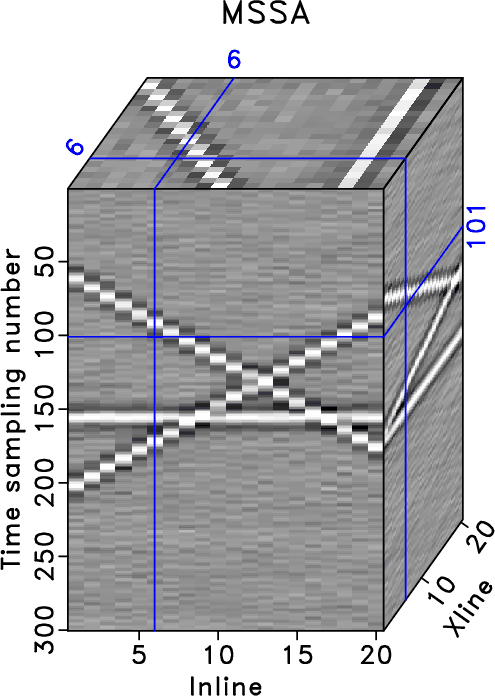
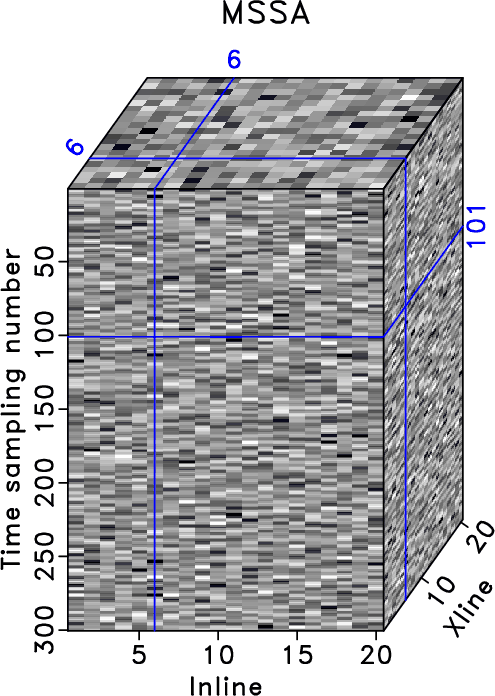



|
|---|
|
synth-clean,synth-mssa,synth-n-mssa,synth-noisy,synth-dmssa,synth-n-dmssa
Figure 1. Denoising comparison of synthetic example. (a) & (d) Clean and noisy data, respectively. (b) & (e) Denoised data using the traditional MSSA and the damped MSSA, respectively. (c) & (f) Removed noise using the traditional MSSA and the damped MSSA, respectively. In the example, |
|
|




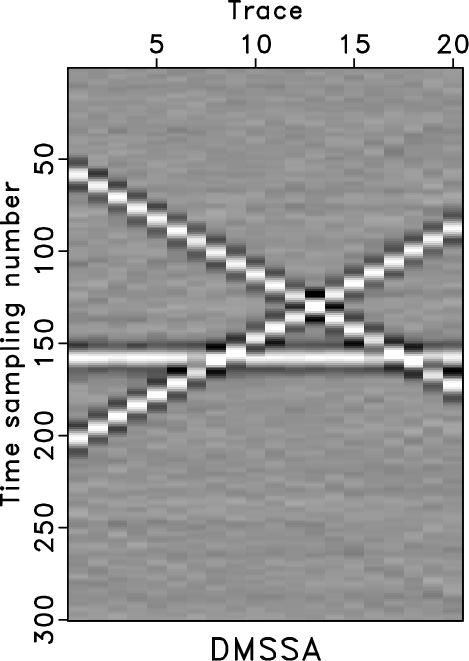
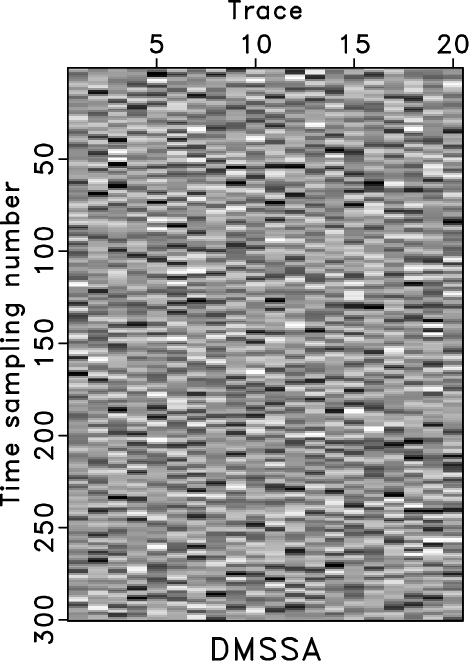
|
|---|
|
synth-s-clean,synth-s-mssa,synth-sn-mssa,synth-s-noisy,synth-s-dmssa,synth-sn-dmssa
Figure 2. Denoising comparison of the 5th crossline section of the synthetic example. (a) & (d) Clean and noisy data, respectively. (b) & (e) Denoised data using the traditional MSSA and the damped MSSA, respectively. (c) & (f) Removed noise using the traditional MSSA and the damped MSSA, respectively. |
|
|
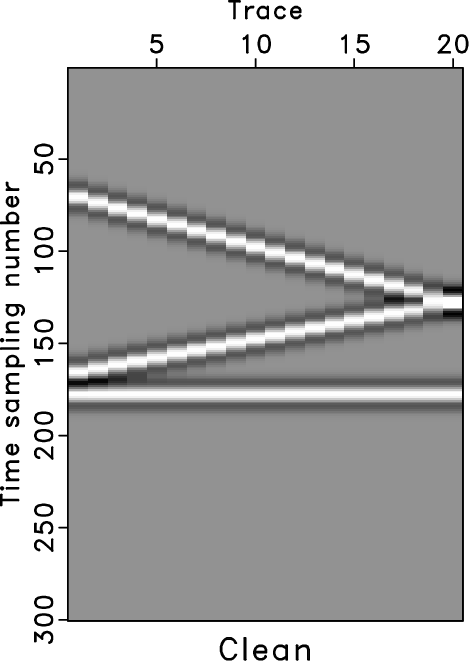


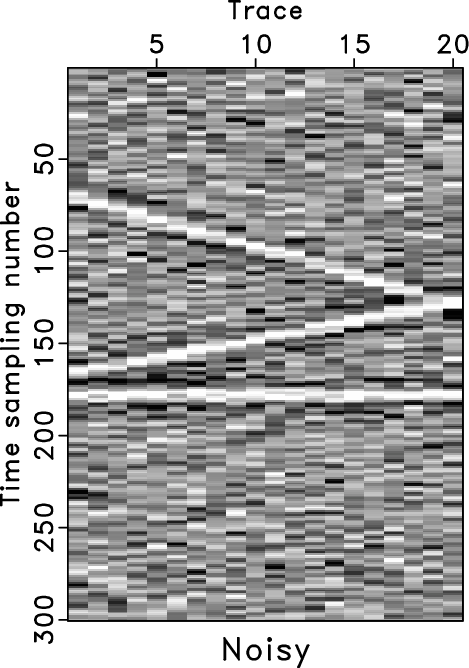

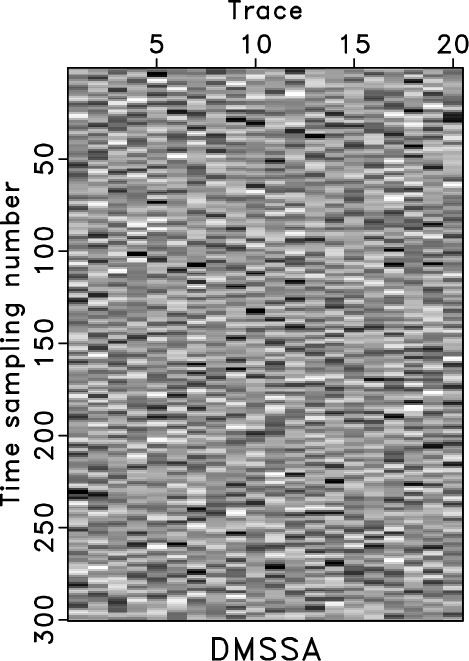
|
|---|
|
synth-s-clean-i,synth-s-mssa-i,synth-sn-mssa-i,synth-s-noisy-i,synth-s-dmssa-i,synth-sn-dmssa-i
Figure 3. Denoising comparison of the 5th inline section of the synthetic example. (a) & (d) Clean and noisy data, respectively. (b) & (e) Denoised data using the traditional MSSA and the damped MSSA, respectively. (c) & (f) Removed noise using the traditional MSSA and the damped MSSA, respectively. |
|
|


|
|---|
|
synth-err1,synth-err2
Figure 4. Denoising error comparison of the 5th inline section of the synthetic example. (a) Error of the traditional MSSA. (b) Error of the damped MSSA. |
|
|


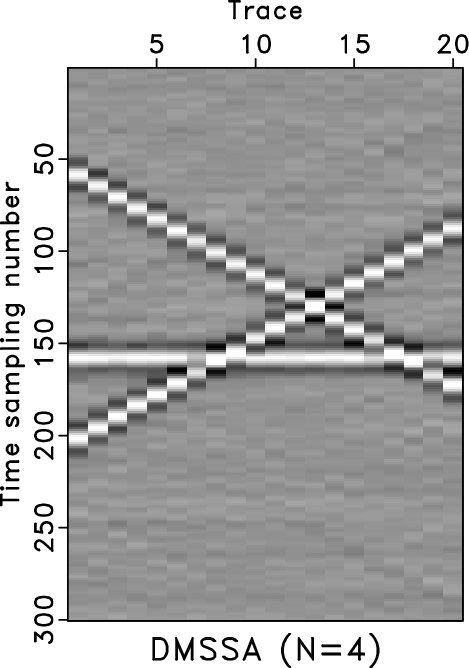


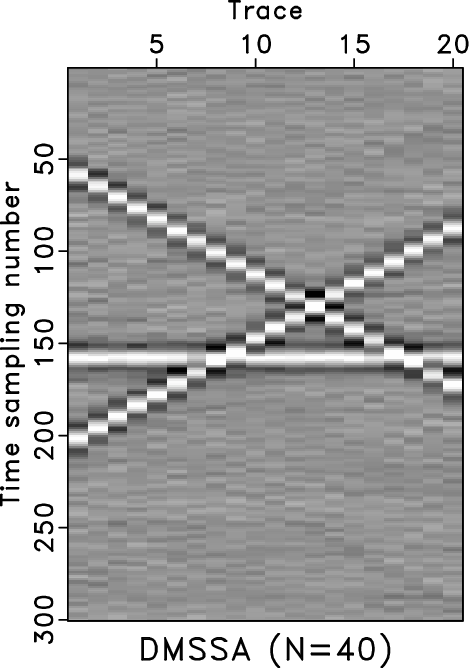
|
|---|
|
synth-s-dmssa-1,synth-s-dmssa-2,synth-s-dmssa-4,synth-s-dmssa-10,synth-s-dmssa-20,synth-s-dmssa-40
Figure 5. Demonstration of the performance with same |
|
|

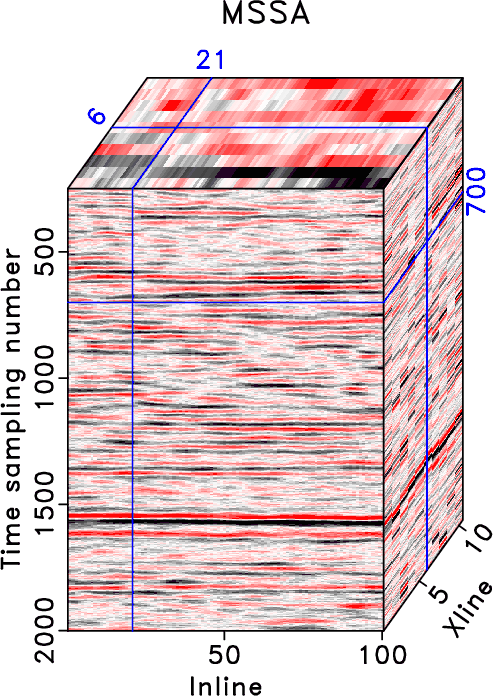


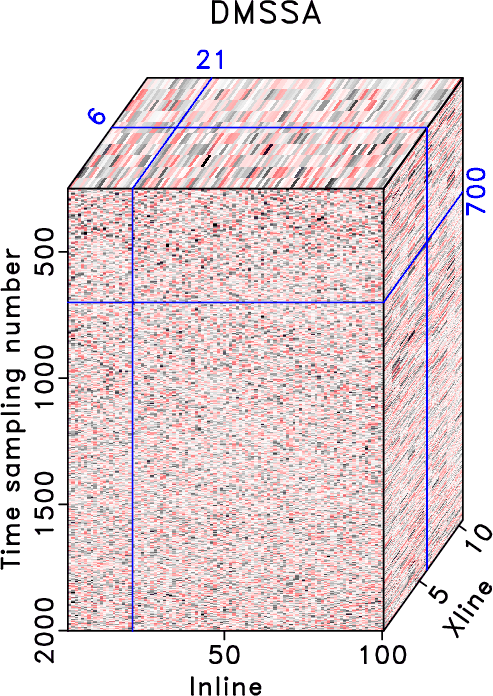
|
|---|
|
field,field-mssa,field-dmssa,field-n-mssa,field-n-dmssa
Figure 6. Denoising comparison of first field data example. (a) Noisy 3D field data. (b) Denoised data using the traditional MSSA. (c) Denoised data using the damped MSSA. (d) Removed noise using the traditional MSSA. (e) Removed noise using the damped MSSA. In the example, |
|
|
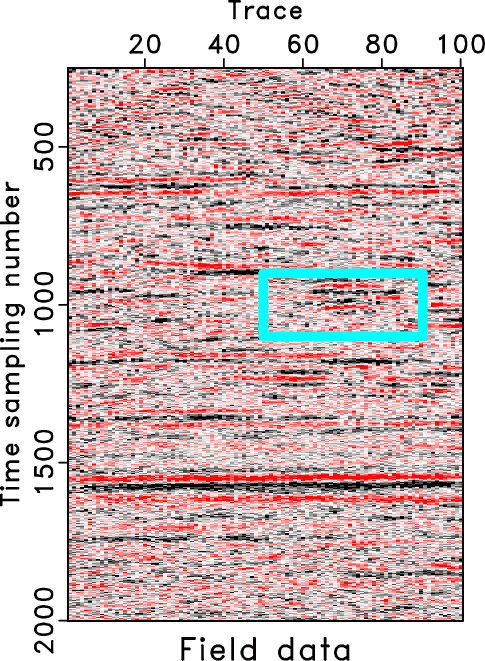


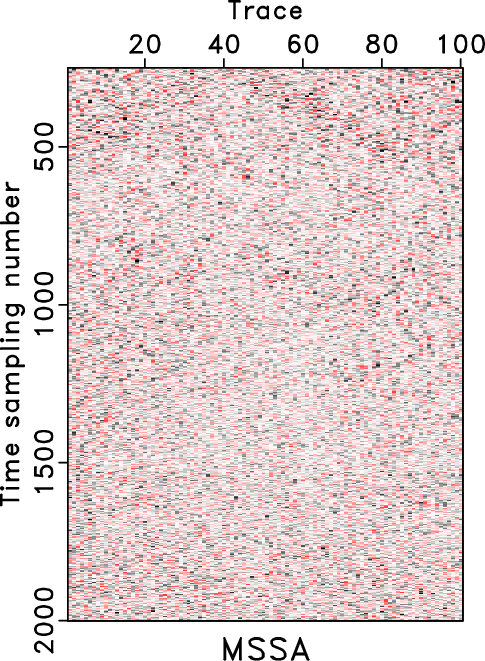

|
|---|
|
field-s-0,field-s-mssa-0,field-s-dmssa-0,field-sn-mssa,field-sn-dmssa
Figure 7. Denoising comparison of the 5th crossline section of field data example. (a) Noisy 3D field data. (b) Denoised data using the traditional MSSA. (c) Denoised data using the damped MSSA. (d) Removed noise using the traditional MSSA. (e) Removed noise using the damped MSSA. |
|
|



|
|---|
|
z-field,z-mssa,z-dmssa
Figure 8. (a) Zoomed section from Figure 7a. (b) Zoomed section from Figure 7b. (c) Zoomed section from Figure 7c. |
|
|





|
|---|
|
field2,field2-mssa,field2-dmssa,field2-n-mssa,field2-n-dmssa
Figure 9. Denoising comparison of second field data example. (a) Noisy 3D field data. (b) Denoised data using the traditional MSSA. (c) Denoised data using the damped MSSA. (d) Removed noise using the traditional MSSA. (e) Removed noise using the damped MSSA. In the example, |
|
|






|
|---|
|
field2-s-0,field2-s-mssa-0,field2-s-dmssa-0,z-field2,z-field2-mssa,z-field2-dmssa
Figure 10. Denoising comparison of the 5th crossline section of field data example. (a) Noisy 3D field data. (b) Denoised data using the traditional MSSA. (c) Denoised data using the damped MSSA. (d) Zoomed section from (a). (e) Zoomed section from (b). (f) Zoomed section from (c). |
|
|